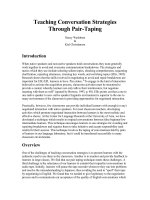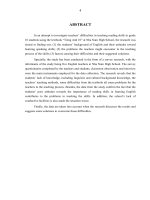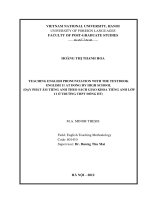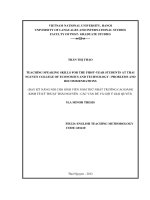Teaching Conversation Skills With Content Based Materials
Bạn đang xem bản rút gọn của tài liệu. Xem và tải ngay bản đầy đủ của tài liệu tại đây (57.57 KB, 3 trang )
Teaching Conversation Skills With
Content Based Materials
Greg Goodmacher
With a little imagination, teachers can create fun lessons that integrate conversation skills
and tasks with various content no matter what the content is and what level the class is.
Through trial, error, and determination, I have found that many of the basic conversation
games and activities that EFL teachers use can be adapted to fit the needs of content
courses. Basically, it is a matter of slipping content into activities commonly used in
conversation classes.
The "Find Someone Who..." activity is very easy to slip content into. In an art college
where I taught English for art I used this activity, and in an environmental studies class I
have also used this activity. In an English for Art class, which I taught for foreign students
in America, I gave each student a small card with information such as the following:
• Your name is Dali. You are a surrealist. I also attached a small picture of one of his
works.
• Your name is Ansel Adams. You are a famous black and white landscape
photographer. I included a small picture of his.
All students received this handout:
Find Someone Who... Write the names of the artists below.
1. is a surrealist __________________
2. is a sculptor __________________
3. is a landscape photographer __________________
4. is a modernist __________________
This was followed up by a discussion activity in which students talked about their favorite
types of art and artists. They also expressed their opinions about the pictures.
My environmental studies class concentrates on using environmental content and issues as
a spring board for improving communication skills. I recently wanted my students to
understand and communicate about endangered species, and I found the "Find Someone
Who..." activity very useful. In this class, after preteaching necessary vocabulary, I gave
each student a card such as the following:
• You are an African elephant. You are endangered because of habitat destruction
and poaching for your ivory. I also attached a picture.
• You are an Atlantic bluefin tuna. You are endangered because of overfishing. I also
attached a picture.
Students received a handout like the one below:
Find Someone Who is... Write the name of the endangered species below.
1. endangered because of poaching for fur __________________
2. endangered because of poaching for ivory __________________
3. endangered because of overfishing __________________
4. endangered because of habitat destruction __________________
Various types of content can be used with the speaking game normally referred to as "20
Questions." In my environmental studies class my students have played this to practice
using vocabulary related to animal classification. Students asked questions such as below:
• Are you a mammal?
• Do you have sharp teeth?
• Are you a carnivore?
• Are you a tiger?
In a mass media based EFL class, my students played "20 Questions" to help them
remember vocabulary related to various types of media and media related occupations.
Each student pretended to have a job in the media. Example questions were:
• Do you work in the print media?
• Do you work in the electronic media?
• Do you appear on television?
• Do you report news?
• Are you a sports reporter?
• Are you an entertainment reporter?
Jig saw activities offer opportunities for mixing content of any type with English
conversation skills. Jig saw activities can be made for teaching all aspects of conversation.
With the jig saw activity described below, I concentrated on listening and speaking skills.
For the environmental studies class, I cut pictures out of a nature magazine. One set of
pictures was about scientists trying to restore bald eagles to states in America where they
no longer live. The other was about marine biologists trying to preserve habitat for sea
horses. Then, using the pictures, I made a poster for each story. The posters were put at
opposite ends of the class. Along with each poster, I placed a cassette player with a tape
recording, which explained the pictures. Using vocabulary which I felt most of the students
knew, I recorded the stories of the pictures, and I added a few relevant words. I pretaught
the new vocabulary to the whole class, and then divided the class into the eagle and sea
horse group and assigned each student a partner who was with the other group. Then, I
explained that half of the class would listen to one tape while taking notes, so that they
could explain the pictures and story to their partner with the other half of class. Students
could play the tape over and over again. They could stop it when they wanted. I informed
them that at the end of class we would play a game, using the information from the posters
and cassette tapes.
I let the students go to their pictures. They listened and wrote notes. I observed the class
and at the point when they appeared to be finished with note taking, I told each student in
the eagle group to pair off with their sea horse group partner and explain the eagle poster.
Next, the sea horse group explained the sea horse poster. After this, I had the class return to
their seats with the partners sitting together. Each pair was assigned a number. I read
questions about the poster stories aloud. The first pair to correctly answer the questions
received a point. Within each pair, sea horse group students could only answer questions
about the eagle picture. Eagle group students could only answer questions about the sea
horse story. They could explain the answer to their partner, but their partner would have to
announce the correct answer to me. The pair with the most correct answers received a small
prize.
These are three examples of mixing content with conversation activities. If you are not
teaching a content based course, but are interested in these ideas, I suggest you do a survey
of your class to find out what interests your students. Then, combine the topics they like
with your conversation class activities. Most of my students in Japan respond that they
want to communicate and learn about music, travel, and foreign cultures. I have found that
students respond favorably to English lessons in which I have integrated their content
choices.









